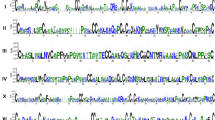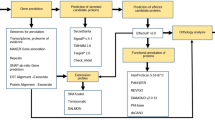Abstract
Plant cysteine-rich peptides (CRP) play a key role in protection of plants from pathogens and abiotic stress, in symbiosis with bacteria, and in plant development and reproduction. The composition and role of CRPs in tomato Solanum lycopersicum, one of the most important vegetable, has not been studied so far. In this paper, using two approaches, hidden Markov models and regular expressions, in silico identification of tomato CRP families was performed. A bioinformatic analysis of NCBI databases revealed 191 CRP precursors. The peptides found belong to the families of antimicrobial and signaling peptides. Among the antimicrobial peptides, defensins and defensin-like peptides, nonspecific lipid-transfer proteins, thionins, snakins, and hevein- and knottin-like peptides were found. Among signaling peptides, the peptides belonging to the RALF, Ole e 1, Ole e 6, and MEG families were discovered. In addition, peptides with new cysteine motifs were identified. All discovered CRPs are synthesized as pre- or preproproteins. The predicted mature peptides were characterized by cysteine motifs, antimicrobial activity, and domain structure. Thus, for the first time, using bioinformatic approaches, systemic data on the arsenal of CRPs in the tomato genome were obtained, which creates a basis for further functional studies of these peptides and their subsequent use in agriculture to develop new strategies for increasing tomato pathogen resistance, as well as in medicine to create next-generation drugs.

Similar content being viewed by others
REFERENCES
Farrokhi, N., Whitelegge, J.P., and Brusslan, J.A., Plant peptides and peptidomics, Plant Biotechnol. J., 2008, vol. 6, no. 2, pp. 105—134. https://doi.org/10.1111/j.1467-7652.2007.00315.x
Silverstein, K.A., Moskal, W.A.Jr., Wu, H.C., et al., Small cysteine-rich peptides resembling antimicrobial peptides have been under-predicted in plants, Plant J., 2007, vol. 51, no. 2, pp. 262—280. https://doi.org/10.1111/j.1365-313X.2007.03136.x
Koehbach, J. and Jackson, K.A.V., Unravelling peptidomes by in silico mining, Peptidomics, 2015, vol. 2, no. 1, pp. 17—25. https://doi.org/10.1515/ped-2015-0002
Choksi, P.M. and Joshi, V.Y., A review on lycopene—extraction, purification, stability and applications, Int. J. Food Prop., 2007, vol. 10, pp. 289—298. https://doi.org/10.1080/10942910601052699
Rowles, J.L. III, Ranard, K.M., Smith, J.W., et al., Increased dietary and circulating lycopene are associated with reduced prostate cancer risk: a systematic review and meta-analysis, Prostate Cancer Prostatic Dis., 2017, vol. 20, no. 4, pp. 361—377. https://doi.org/10.1038/pcan.2017.25
Cavallini, C., Trettene, M., Degan, M., et al., Anti-angiogenic effects of two cystine-knot miniproteins from tomato fruit, Br. J. Pharmacol., 2011, vol. 162, no. 6, pp. 1261—1273. https://doi.org/10.1111/j.1476-5381.2010.01154.x
Odintsova, T.I., Slezina, M.P., Istomina, E.A., et al., Defensin-like peptides in wheat analyzed by whole-transcriptome sequencing: a focus on structural diversity and role in induced resistance, Peer J., 2019, vol. 7. e6125. https://doi.org/10.7717/peerj.6125
Bendtsen, J.D., Nielsen, H., von Heijne, G., and Brunak, S., Improved prediction of signal peptides: SignalP 3.0, J. Mol. Biol., 2004, vol. 340, no. 4, pp. 783—795. https://doi.org/10.1016/j.jmb.2004.05.028
Kozlowski, L.P., IPC—Isoelectric Point Calculator, Biol. Direct., 2016, vol. 11, no. 55. https://doi.org/10.1186/s13062-016-0159-9
Porto, W.F., Pires, Á.S., and Franco, O.L., CS-AMPPred: an updated SVM model for antimicrobial activity prediction in cysteine-stabilized peptides, PLoS One, 2012, vol. 7, no. 12. e51444. https://doi.org/10.1371/journal.pone.0051444
Waghu, F.H., Barai, R.S., Gurung, P., and Idicula-Thomas, S., CAMPR3: a database on sequences, structures, and signatures of antimicrobial peptides, Nucleic Acids Res., 2016, vol. 44, no. D1, pp. D1094—D1097. https://doi.org/10.1093/nar/gkv1051
Gasteiger, E., Hoogland, C., Gattiker, A., et al., Protein identification and analysis tools on the ExPASy server, The Proteomics Protocols Handbook / Ed. Walker John M. Humana Press, 2005, pp. 571—607.
Hirokawa, T., Boon-Chieng, S., and Mitaku, S., SOSUI: classification and secondary structure prediction system for membrane proteins, Bioinformatics, 1998, vol. 14, no. 4, pp. 378—379.
Wang, G., Li, X., and Wang, Z., APD3: the antimicrobial peptide database as a tool for research and education, Nucleic Acids Res., 2016, vol. 44, no. D1, pp. D1087—D1093. https://doi.org/10.1093/nar/gkv1278
Quevillon, E., Silventoinen, V., Pillai, S., et al., InterProScan: protein domains identifier, Nucleic Acids Res., 2005, vol. 33, pp. W116—W120. https://doi.org/10.1093/nar/gki442
Lay, F.T. and Anderson, M.A., Defensins—components of the innate immune system in plants, Curr. Protein Pept. Sci., 2005, vol. 6, no. 1, pp. 85—101. https://doi.org/10.2174/1389203053027575
Parisi, K., Shafee, T.M.A., Quimbar, P., et al., The evolution, function and mechanisms of action for plant defensins, Semin. Cell Dev. Biol., 2019, vol. 88, pp. 107—118. https://doi.org/10.1016/j.semcdb.2018.02.004
Stotz, H.U., Spence, B., and Wang, Y., A defensin from tomato with dual function in defense and development, Plant Mol. Biol., 2009, vol. 71, nos. 1–2, pp. 131—143. https://doi.org/10.1007/s11103-009-9512-z
Harris, F., Dennison, S.R., and Phoenix, D.A., Anionic antimicrobial peptides from eukaryotic organisms, Curr. Protein Pept. Sci., 2009, vol. 10, no. 6, pp. 585—606. https://doi.org/10.2174/138920309789630589
Kader, J.C., Lipid-transfer proteins in plants, Annu. Rev. Plant Physiol. Plant Mol. Biol., 1996, vol. 47, pp. 627—654. https://doi.org/10.1146/annurev.arplant.47.1.627
Slavokhotova, A.A., Shelenkov, A.A., Andreev, Y.A., and Odintsova, T.I., Hevein-like antimicrobial peptides of plants, Biochemistry (Moscow), 2017, vol. 82, no. 13, pp. 1659—1674. https://doi.org/10.1134/S0006297917130065
Van den Bergh, K.P., Rougé, P., Proost, P., et al., Synergistic antifungal activity of two chitin-binding proteins from spindle tree (Euonymus europaeus L.), Planta, 2004, vol. 219, no. 2, pp. 221—232. https://doi.org/10.1007/s00425-004-1238-1
Slavokhotova, A.A., Naumann, T.A., Price, N.P., et al., Novel mode of action of plant defense peptides—hevein-like antimicrobial peptides from wheat inhibit fungal metalloproteases, FEBS J., 2014, vol. 281, no. 20, pp. 4754—4764. https://doi.org/10.1111/febs.13015
Harris, P.W., Yang, S.H., Molina, A., et al., Plant antimicrobial peptides snakin-1 and snakin-2: chemical synthesis and insights into the disulfide connectivity, Chemistry, 2014, vol. 20, no. 17, pp. 5102—5210. https://doi.org/10.1002/chem.201303207
Berrocal-Lobo, M., Segura, A., Moreno, M., et al., Snakin-2, an antimicrobial peptide from potato whose gene is locally induced by wounding and responds to pathogen infection, Plant Physiol., 2002, vol. 128, no. 3, pp. 951—961. https://doi.org/10.1104/pp.010685
Segura, A., Moreno, M., Madueño, F., et al., Snakin-1, a peptide from potato that is active against plant pathogens, Mol. Plant—Microbe Interact., 1999, vol. 12, no. 1, pp. 16—23. https://doi.org/10.1094/MPMI.1999.12.1.16
Almasia, N.I., Bazzini, A.A., Hopp, H.E., and Vazquez-Rovere, C., Overexpression of snakin-1 gene enhances resistance to Rhizoctonia solani and Erwinia carotovora in transgenic potato plants, Mol. Plant Pathol., 2008, vol. 9, no. 3, pp. 329—338.
Nahirñak, V., Almasia, N.I., Fernandez, P.V., et al., Potato snakin-1 gene silencing affects cell division, primary metabolism, and cell wall composition, Plant Physiol., 2012, vol. 158, no. 1, pp. 252—263. https://doi.org/10.1104/pp.111.186544
Tam, J.P., Wang, S., Wong, K.H., and Tan, W.L., Antimicrobial peptides from plants, Pharmaceuticals (Basel), 2015, vol. 8, no. 4, pp. 711—757. https://doi.org/10.3390/ph8040711
Cotabarren, J., Tellechea, M.E., Tanco, S.M., et al., Biochemical and MALDI-TOF mass spectrometric characterization of a novel native and recombinant cystine knot miniprotein from Solanum tuberosum subsp. andigenum cv. Churqueña, Int. J. Mol. Sci., 2018, vol. 19, no. 3. pii: E678. https://doi.org/10.3390/ijms19030678
Stec, B., Plant thionins—the structural perspective, Cell. Mol. Life Sci., 2006, vol. 63, no. 12, pp. 1370—1385. https://doi.org/10.1007/s00018-005-5574-5
Pearce, G., Moura, D.S., Stratmann, J., and Ryan, C.A., Jr., RALF, a 5-kDa ubiquitous polypeptide in plants, arrests root growth and development, Proc. Natl. Acad. Sci. U.S.A., 2001, vol. 98, no. 22, pp. 12843—12847. https://doi.org/10.1073/pnas.201416998
Bedinger, P.A., Pearce, G., and Covey, P.A., RALFs: peptide regulators of plant growth, Plant Signal. Behav., 2010, vol. 5, no. 11, pp. 1342—1346. https://doi.org/10.4161/psb.5.11.12954
Chen, L.Y., Small peptides, big roles—RALFs regulate pollen tube growth and burst in plant reproduction, J. Genet. Genomics, 2018, vol. 45, no. 3, pp. 121—123. https://doi.org/10.1016/j.jgg.2018.02.006
Quiralte, J., Palacios, L., Rodríguez, R., et al., Modelling diseases: the allergens of Olea europaea pollen, J. Invest. Allergol. Clin. Immunol., 2007, vol. 17, suppl. 1, pp. 76—82.
Villalba, M., Batanero, E., Monsalve, R.I., et al., Cloning and expression of Ole e I, the major allergen from olive tree pollen: polymorphism analysis and tissue specificity, J. Biol. Chem., 1994, vol. 269, no. 21, pp. 15217—15222.
Treviño, M.A., García-Mayoral, M.F., Barral, P., et al., NMR solution structure of Ole e 6, a major allergen from olive tree pollen, J. Biol. Chem., 2004, vol. 279, no. 37, pp. 39035—39041. https://doi.org/10.1074/jbc.M406045200
Gutiérrez-Marcos, J.F., Costa, L.M., Biderre-Petit, C., et al., maternally expressed gene1 is a novel maize endosperm transfer cell-specific gene with a maternal parent-of-origin pattern of expression, Plant Cell, 2004, vol. 16, no. 5, pp. 1288—1301. https://doi.org/10.1105/tpc.019778
Milligan, S.B. and Gasser, C.S., Nature and regulation of pistil-expressed genes in tomato, Plant Mol. Biol., 1995, vol. 28, no. 4, pp. 691—711.
Baxter, A.A., Richter, V., Lay, F.T., et al., The tomato defensin TPP3 binds phosphatidylinositol (4,5)-bisphosphate via a conserved dimeric cationic grip conformation to mediate cell lysis, Mol. Cell. Biol., 2015, vol. 35, no. 11, pp. 1964—1978. https://doi.org/10.1128/MCB.00282-15
Rigano, M.M., Romanelli, A., Fulgione, A., et al., A novel synthetic peptide from a tomato defensin exhibits antibacterial activities against Helicobacter pylori,J. Pept. Sci., 2012, vol. 18, no. 12, pp. 755—762. https://doi.org/10.1002/psc.2462
Tomassen, M.M., Barrett, D.M., van der Valk, H.C., and Woltering, E.J., Isolation and characterization of a tomato non-specific lipid transfer protein involved in polygalacturonase-mediated pectin degradation, J. Exp. Bot., 2007, vol. 58, no. 5, pp. 1151—1160. https://doi.org/10.1093/jxb/erl288
Mitton, F.M., Pinedo, M.L., and de la Canal, L., Phloem sap of tomato plants contains a DIR1 putative ortholog, J. Plant Physiol., 2009, vol. 166, no. 5, pp. 543—547.
Volpicella, M., Leoni, C., Fanizza, I., et al., Expression and characterization of a new isoform of the 9 kDa allergenic lipid transfer protein from tomato (variety San Marzano), Plant Physiol. Biochem., 2015, vol. 96, pp. 64—71. https://doi.org/10.1016/j.plaphy.2015.07.019
Balaji, V. and Smart, C.D., Over-expression of snakin-2 and extensin-like protein genes restricts pathogen invasiveness and enhances tolerance to Clavibacter mi-chiganensis subsp. michiganensis in transgenic tomato (Solanum lycopersicum), Transgenic Res., 2012, vol. 21, no. 1, pp. 23—37. https://doi.org/10.1007/s11248-011-9506-x
Herbel, V., Sieber-Frank, J., and Wink, M., The antimicrobial peptide snakin-2 is upregulated in the defense response of tomatoes (Solanum lycopersicum) as part of the jasmonate-dependent signaling pathway, J. Plant Physiol., 2017, vol. 208, pp. 1—6. https://doi.org/10.1016/j.jplph.2016.10.006
Díez-Díaz, M., Conejero, V., Rodrigo, I., et al., Isolation and characterization of wound-inducible carboxypeptidase inhibitor from tomato leaves, Phytochemistry, 2004, vol. 65, no. 13, pp. 1919—1924. https://doi.org/10.1016/j.phytochem.2004.06.007
Molesini, B., Rotino, G.L., Dusi, V., et al., Two metallocarboxypeptidase inhibitors are implicated in tomato fruit development and regulated by the Inner No Outer transcription factor, Plant Sci., 2018, vol. 266, pp. 19—26. https://doi.org/10.1016/j.plantsci.2017.10.011
Muschietti, J., Dircks, L., Vancanneyt, G., and McCormick, S., LAT52 protein is essential for tomato pollen development: pollen expressing antisense LAT52 RNA hydrates and germinates abnormally and cannot achieve fertilization, Plant J., 1994, vol. 6, no. 3, pp. 321—338.
Shelenkov, A.A., Slavokhotova, A.A., and Odintsova, T.I., Cysmotif searcher pipeline for antimicrobial peptide identification in plant transcriptomes, Biochemistry (Moscow), 2018, vol. 83, no. 11, pp. 1424—1432. https://doi.org/10.1134/S0006297918110135
Funding
This study was supported by the Russian Science Foundation (grant no. 16-16-00032).
Author information
Authors and Affiliations
Corresponding author
Ethics declarations
The authors declare that they have no conflict of interest. This article does not contain any studies involving animals or human participants performed by any of the authors.
Supplementary material
Rights and permissions
About this article
Cite this article
Istomina, E.A., Slezina, M.P., Kovtun, A.S. et al. In Silico Identification of Gene Families Encoding Cysteine-Rich Peptides in Solanum lycopersicum L.. Russ J Genet 56, 572–579 (2020). https://doi.org/10.1134/S1022795420050063
Received:
Revised:
Accepted:
Published:
Issue Date:
DOI: https://doi.org/10.1134/S1022795420050063




